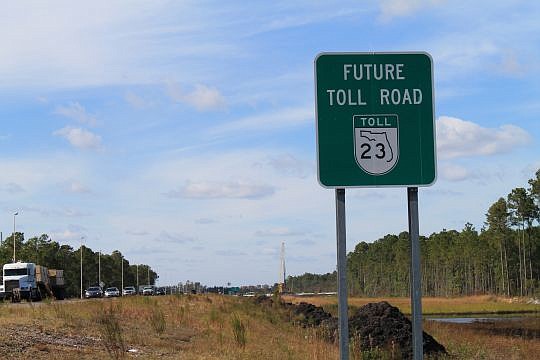
Early signs of construction on the First Coast Expressway are here.
Take a trip south from Interstate 10 on Chaffee Road and a detour weaves next to reinforced concrete pilings, swaths of shaved earth and rows of stacked dirt.
Now that this growth-driving project has broken ground, are developers on Jacksonville’s Westside and Clay County readying upward of 50,000 lots for new homes?
The answer: Not just yet.
One mile to the east of construction, Lennar Homes in September unveiled the first 300 lots in its new Longleaf community and has started to develop 500 more. But a company representative said the expressway has not been an influence.
Likewise Dream Finders Homes, one of Clay County’s top builders, is not making big moves until after the expressway is finished.
Developers are more short-term in their outlook, said Dream Finders President Patrick Zalupski. A deal’s financials need to work at today’s prices, not what they will become in two years, when a highway is finished.
There’s no doubt in many people’s minds, though, that the First Coast Expressway will be a game changer, especially for Clay County.
“It is going to be possibly the greatest single impact this county has had in a long time,” said Michael Bourré of Bourré Construction Group. “We’re going to see significant development because of the ease of access it creates.”
The First Coast Expressway loops around Jacksonville’s southwest corner, concentric with, but farther out than I-295. When finished, it will connect I-10 west of Jacksonville at Cecil Commerce Parkway to I-95 south of the city at County Road 210, skipping along the eastern edge of the Cecil Commerce Center and passing through Green Cove Springs on the way.
The first phase of the project is under construction and slated for completion in 2016. It will run from I-10, south to Blanding Boulevard, easing traffic for Westside commuters driving to Cecil Commerce Center and to Jacksonville via I-10.
But the big payoff for residential developers is going to come from a later phase, Zalupski said, one that connects Green Cove Springs to I-95.
“It’s going to be a big deal, because it will cut the commute time from Green Cove to the Southside to about 20 minutes. Thirty minutes to Downtown,” he said. “Those are major employment centers.”
The same commute now takes 45 minutes to an hour.
Access matters, because jobs drive demand for new homes, more directly so than freeways alone.
To compare, the majority of recent development in St. Johns County has occurred along the I-95 corridor south of Jacksonville.
“People in Clay County will be able to get to work, send their kids to A-rated schools and buy a house for $30,000 to $50,000 less than if they lived in St. Johns County,” Zalupski said.
If access to jobs helps residential growth, actual jobs will help even more. That’s what planners think a finished expressway will bring to Clay County.
Today, no major interstates run into the county, said Bill Garrison, president of the Clay County Economic Development Corp. The only one that touches Clay is I-295, which skirts along the county’s northern border. As a result, Orange Park is where most of the county’s development has been.
“If you get a big interstate, you’ll have the truck transportation that will allow for the movement of goods back and forth,” Garrison said. “It puts Clay County in the interstate game.”
Homebuilders may not think the expressway is impacting development, Garrison said, but it already has. St. Vincent’s a few years ago opened a hospital in Clay County, choosing its location in part because of the planned expressway. The hospital brought 700 new jobs to Clay.
“They may not see the connection, but I promise you, it’s there,” Garrison said.
If residential developers aren’t yet planning for the coming expressway, the county has
been.
Clay County began master-planning areas surrounding the new highway corridor as soon as the state department of transportation announced the project, converting agriculturally zoned areas into residential neighborhoods and commercial nodes.
“Without it, we would get a lot of piecemeal development,” said Holly Parrish, Clay County’s Economic Development director. “And the county couldn’t plan for adequate infrastructure.”
The Branan Field master-planned community, on the future expressway’s west side, is zoned for 25,000 multi- and single-family homes. To the south, Lake Asbury can hold 22,780. Developers are already building in those areas.
Closer to Green Cove Springs, Clay County has also approved two developments of regional impact.
Saratoga Springs is authorized for almost 4,300 homes and Governor’s Park is authorized for 6,300.
Those plans are not in anticipation of Clay County becoming an even larger bedroom community for Duval either.
“We want to not be so dependent on a residential tax base. That’s what we’ve been for years,” Parrish said. “Our board is very pro-business and we have an incentive package to get real job producers here.”
(904) 356-2466